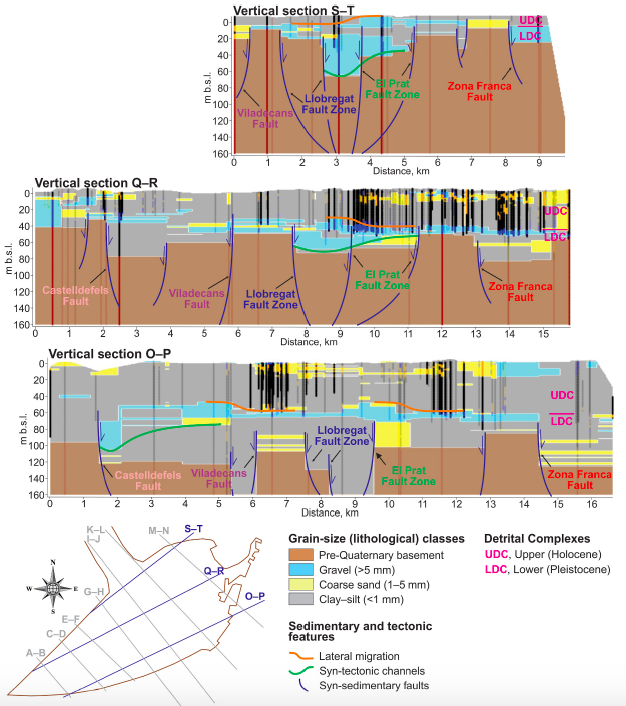This paper introduces a methodology based on Python libraries and machine learning k-Nearest Neighbors (KNN) algorithms to create an interactive 3D HTML model (3D_Vertical_Sections_Faults_LRD.html) that combines 2D grain-size KNN-prediction vertical maps (vertical sections) from which syn-sedimentary faults and other features in sedimentary porous media can be delineated. The model can be visualized and handled with conventional web browsers. The grain-size physical parameter is measurable, constant over instrumental time, handleable mathematically, and its range can be associated to lithological classes. Grain-size input data comes from a public database of 433 boreholes in the Llobregat River Delta (LRD) in NE Spain. Four lithological classes were defined: Pre-Quaternary basement, and Quaternary gravel, sand, and clay–silt. Using a new KNN-prediction algorithm, seven NW–SE (transversal) and three SW–NE (longitudinal) vertical sections were created following the orientation of faults identified in surface and detected in reflection seismic geophysical surveys. For exploratory K values in the 1–75 range were used. K around 25 provides the general and smoothy shape of the basement top surface, whereas K = 1 is a optimal value to represent the heterogeneity of the LRD at short distance. Using a new KNN-prediction confidence algorithm inspired in the Similarity Ratio algorithm for machine-learning KNN, the vertical sections overall confidence was evaluated as satisfactory. A general decreasing confidence trend according to the decreasing data density with depth and from inland to seaward was found. The vertical sections created with K = 1 show horizontal interruptions (displacements or vertical steps) in the basement continuity and in the Quaternary coarse bodies (gravel and sand) attributable to the action of Quaternary active faults. These faults have been linked or correlated with well-known active faults in the area related in much cases with the Valencia Trough opening. Moreover, several faults detected in surface and other identified in this paper by the first time have been revealed as fault zones made of fault branches with different steps in an echelon-like arrangement.

Faulting seems to be more evident in the Pleistocene Lower Detrital Complex and much less active or inactive in the Holocene Upper Detrital Complex. Syn-tectonic gravel channels faulty controlled, progradation of gravel lobes, and lateral migration of channel bars were also observed. At its current development stage, this methodology could also be applied to other geological environments, making the due minor modifications of the code, and is especially suitable to reduce the high (usually unmeasurable) uncertainty associated to the qualitative geological data used in more complex numerical tools aimed at modelling a lot of geological resources (groundwater, minerals, geothermal, petroleum) or different Earth phenomena.
Cite as: Martín-Martín, M., Bullejos, M., Cabezas, D., Alcalá, F. J., (2023). Using python libraries and k-Nearest neighbors algorithms to delineate syn-sedimentary faults in sedimentary porous media. Marine and Petroleum Geology, 153. 106283. doi: 10.1016/j.marpetgeo.2023.106283
Recent Comments